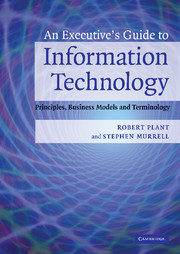Book contents
- Frontmatter
- Contents
- Introduction
- A ACM (Association for Computing Machinery) to Audio
- B Backup to Business process re-engineering
- C C, C++, C# to Cracking
- D Database to Dynamic web pages
- E e-Commerce/e-business to European Union Directive on Privacy and Electronic Commerce 2002
- F Fiber optics to Fuzzy logic
- G to H Global positioning system to Hypertext, HTML
- I ICANN (Internet Corporation for Assigned Names and Numbers) to ISP (Internet service provider)
- J to L Java to Logic programming
- M Machine learning to Multicast
- N Natural language processing (NLP) to Normalization
- O Object-oriented to Outsourcing
- P Packet switching and circuit switching to Public key-private key
- Q to R Quantum computing to RSS (Really simple syndication)
- S Sarbanes-Oxley Act of 2002 (SOX) to Structured design methodologies
- T to U T-Carrier to URL (Uniform resource locator)
- V Value added network (VAN) to Voice over IP (VoIP)
- W W3C (the World Wide Web Consortium) to WYSIWYG
- X to Z X.12 to Zip
- Index
- References
E - e-Commerce/e-business to European Union Directive on Privacy and Electronic Commerce 2002
Published online by Cambridge University Press: 17 May 2010
- Frontmatter
- Contents
- Introduction
- A ACM (Association for Computing Machinery) to Audio
- B Backup to Business process re-engineering
- C C, C++, C# to Cracking
- D Database to Dynamic web pages
- E e-Commerce/e-business to European Union Directive on Privacy and Electronic Commerce 2002
- F Fiber optics to Fuzzy logic
- G to H Global positioning system to Hypertext, HTML
- I ICANN (Internet Corporation for Assigned Names and Numbers) to ISP (Internet service provider)
- J to L Java to Logic programming
- M Machine learning to Multicast
- N Natural language processing (NLP) to Normalization
- O Object-oriented to Outsourcing
- P Packet switching and circuit switching to Public key-private key
- Q to R Quantum computing to RSS (Really simple syndication)
- S Sarbanes-Oxley Act of 2002 (SOX) to Structured design methodologies
- T to U T-Carrier to URL (Uniform resource locator)
- V Value added network (VAN) to Voice over IP (VoIP)
- W W3C (the World Wide Web Consortium) to WYSIWYG
- X to Z X.12 to Zip
- Index
- References
Summary
Definition: e-Commerce/e-business are business models that utilize the internet as a mechanism through which companies, vendors, and customers interact.
Overview
e-Commerce originated with the deregulation of the internet in 1995. It was originally conceived as a business-to-customer (B2C) model of commerce, and corporations were formed to provide services and products over the internet without having any physical retail presence (e.g., Amazon.com, the well-known online book seller).
The term e-Business was coined by Lou Gerstner, then CEO of IBM, who looked beyond the B2C model to use the internet for delivering services and supporting physical business channels.
The start-up companies that adopted pure B2C commerce, for which there is no physical retail store, together with startup business-to-business (B2B) organizations, which also owned no physical retailing or warehousing capacity, aimed to “disintermediate” the established companies by having lower internal and distribution-channel costs. Unfortunately, this model proved to be very expensive to support as the businesses attempted to scale up and reach profitability, and the majority ran out of capital following the decline in the US stock market of 2000 and closed down. Those that survived the stock-market crash endured a market consolidation and continue to attempt to build market share, drive down costs, and become profitable or maintain profitability.
- Type
- Chapter
- Information
- An Executive's Guide to Information TechnologyPrinciples, Business Models, and Terminology, pp. 123 - 142Publisher: Cambridge University PressPrint publication year: 2007



